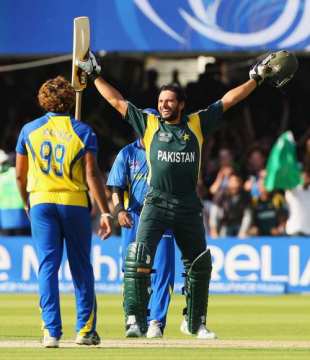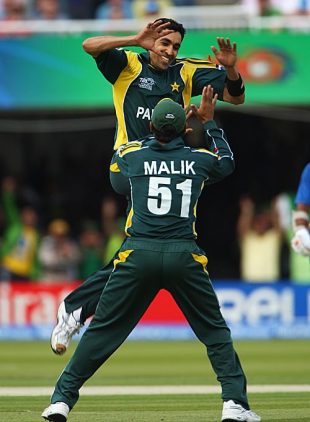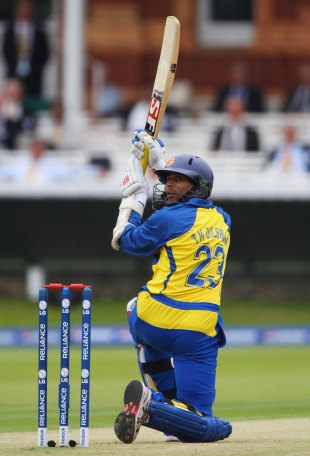ICC World Twenty20, 2009
Hugh Chevallier
1. Pakistan, 2. Sri Lanka, 3= South Africa and West Indies

|
|||
|
Related Links
Andrew Miller : The best fun imaginable
Feature : Freeze frames Feature : The top crop Feature : Wickets and runs galore, but fewer sixes Audio/Video:
'Pakistan needed the victory the most'
Series/Tournaments:
ICC World Twenty20
Teams:
Australia
| Bangladesh
| England
| India
| Ireland
| Netherlands
| New Zealand
| Pakistan
| Scotland
| Scotland XI
| South Africa
| Sri Lanka
| West Indies
|
|||
After March's terrorist outrage in Lahore brought international cricket in Pakistan to an abrupt halt, some questioned whether the national team, seemingly destined to wander the globe as a latter-day Flying Dutchman, could remain a force in world cricket. At Lord's, on the longest day, Pakistan gave an eloquent riposte to the doubters by outplaying Sri Lanka and winning the second ICCWorld Twenty20. No other nation needed this triumph as much as Pakistan and, after they put a ropy start behind them, no other nation deserved this triumph as much as Pakistan. The fortnight made a compelling story (complete with its own flying Dutchmen), touchingly concluded by Younis Khan dedicating victory to the memory of Bob Woolmer, the Pakistan coach who died during the 2007 World Cup.
Younis also implored touring teams to return to Pakistan. That seemed unlikely, but the stock of Pakistani cricket had risen, and as well as giving a huge boost to millions at home it would have served to endorse the ECB's decision, announced less than a week after the tournament, to host a Pakistan v Australia Test series in July 2010. This was not entirely an act of altruism by the ECB, who can often spot a commercial opportunity when they see one (sometimes to the detriment of the cricket). In the UK, only England and India, though not necessarily in that order, enjoy a bigger following than Pakistan. Indeed the cosmopolitan nature of the consistently large crowds was a distinctive characteristic of the World Twenty20: all 12 teams attracted decent support. The ICC claimed roughly 96% of seats were sold, suggesting that ticket prices were pitched about right. For adults, the range was from £15-£90; for children, it was an enlightened £8-£15.
For pretty much everyone, that represented excellent value for money: most tickets were for double-headers, and if one match was one-sided, chances were the other was a minor gem. It all got off to a cracking start, too, provided you weren't at Lord's hoping to see England move smoothly towards the next phase with a morale-boosting win over supposed Dutch makeweights, or Alesha Dixon sing for her supper. Late May and the beginning of June had seen England basking in early summer sun, but the weather broke at the wrong time, scuppering the opening ceremony and delaying the England-Netherlands game.
It was worth the wait. The match was a classic: a final over of delicious tension ended in a memorable upset, a pitch invasion by sprinting Dutchmen and headlines the world over. "CLOGS 1, CLOTS 0" was the Sun's take on England's humbling, while the News of the World chose "EDAMMED". Others preferred fruitier options, insisting that England had been reduced to lemons by slipping on an Orange banana skin. It was nothing less than either side deserved, one harrying and fighting for all they were worth, the other treating the game as glorified practice. Defeat raised the spectre of England's ignominious World Cup campaign of 1999 when they crashed out of their own tournament at the first hurdle. Their minds focused, England made light of a rusty Pakistan to qualify for the Super Eights; the Dutch would join them if they avoided a heavy defeat by Pakistan. That proved a step too far, but they returned to the Netherlands buoyed by the biggest night in their cricketing history.
The seeding system dictated that West Indies, because of their failure at the first World Twenty20, joined Australia and Sri Lanka in the toughest group. Just as he had in the opening game in 2007, Chris Gayle lit up the tournament with an innings of sheer brilliance, only this time it brought victory, against the shell-shocked Australians. Two days later, Australia lost to Sri Lanka, and were gone; Ricky Ponting's Ashes-bound team were left kicking their heels for a fortnight. The only Test side ousted before them were Bangladesh, well beaten by both India and Ireland. In the last group, Scotland fought spiritedly in a rain-reduced contest with New Zealand, but collapsed in a heap against a well-drilled South Africa.
Because time prevented a single Super Eight group in which all played all, no points were carried from the group stages. And because the organisers were keen to allow spectators to book ahead to follow their team, fixtures and venues were preordained, provided the seeded team progressed. (In reality, Australia's place was taken by West Indies, and Bangladesh's by Ireland.) The result was the fortnight's one structural weakness: with no incentive for a team to finish top of the table, the last three group matches were meaningless.
Meaning kicked in again for the Super Eights. In Group E, South Africa brushed England aside with disdainful ease and followed up with a convincing win over West Indies, all but guaranteeing a place in the semis. West Indies, thanks to the all-round excellence of Dwayne Bravo, defeated India, who never found the zest and confidence that brought them the first World Twenty20. Their captain, Mahendra Singh Dhoni, repeatedly denied that his players were exhausted by the recently concluded IPL; and they had to cope without Virender Sehwag, who had a shoulder injury, and whose absence left India's top order vulnerable to the short ball. Once they lost to England in a frenzied atmosphere at Lord's, the holders were out. That set up a virtual quarter-final between England and West Indies. But the game was sabotaged by the weather briefly forgetting its manners - and the Duckworth/Lewis method its even-handedness. Or so it seemed: a revised target of 80 from nine overs surely provided a lesser obstacle than 162 from 20, and West Indies, not England, progressed.
Sri Lanka sailed through Group F unbeaten and Ireland bumped winless along the bottom, only that doesn't quite tell the story. Ireland were never humbled, and even threatened an upset against Sri Lanka, who had to fight hard to defend 144 after a rare failure from Tillekeratne Dilshan. Pakistan lost to Sri Lanka before despatching New Zealand thanks to the bowling performance of the fortnight: Umar Gul's late-swinging yorkers left the batting in tatters. In fact, New Zealand had been in tatters since arriving in England. Fancied by some as possible winners, they were hamstrung by injuries. Daniel Vettori, the captain and canniest of slow bowlers, was never fully fit, while an infection meant Jesse Ryder, possibly Gayle's rival as the hardest hitter, withdrew after one match; Ross Taylor also struggled for fitness.

|
|||
The semis pitted South Africa and Sri Lanka, both still unbeaten, against the volatile forces of Pakistan and West Indies. In the first, the hit-or-miss phenomenon that is Shahid Afridi proved a very palpable hit and condemned South Africa to the familiar fate of promising much and delivering little. In the second, the West Indies batting inexplicably committed collective hara-kiri and, genius though he is, Gayle could not overhaul Sri Lanka single-handed. Spectators were given a variation on the double-header when the semi-finals and final of the men's and women's events coincided. This laudable move brought women's cricket to a wider audience (and, in England's magnificently cool-headed pursuit of a stiff Australian target in the second semi-final, one of the matches of the fortnight - see page 563). Neither of the 2009 finals was one to savour. The side bowling first - the English women and the Pakistani men - were in dominant positions before the halfway mark, and won with few scares.
Structurally, the second tournament was a clone of the first. That's no criticism: the South African was an out-and-out winner, and the ICC wisely, if uncharacteristically, decided that if it ain't broke, don't fix it. So Steve Elworthy, tournament director in 2007, reprised his role to oversee another hugely successful contest. Some fringe elements, such as the dancers and resident DJ, lacked the freshness and vitality they had before, while it is kindest not to dwell on one addition, an utterly pointless episode before each match in which a member of the crowd was driven round the outfield in a golf buggy and lobbed a single delivery at a retired international player.
But they were minor cavils and, in at least one important respect, the second coming was an improvement on the first. This time there was a greater balance between bat and ball. Although the average first-innings score fell only slightly from 160 to 156, the drop was significant, especially in the Super Eight and knockout stages, when it fell from 159 to 150. The lower altitude of the English grounds was partly the cause, with the number of sixes tumbling from 265 to 166. But so were the slow pitches at Trent Bridge and, later in the tournament, at Lord's, and the spinners' ability to exploit them.
Research published on Cricinfo showed that between the seventh and 14th overs of the 2009 tournament, typically bowled by the spinners after the end of the powerplay, the run-rate dwindled from 7.75 to 6.77. (Two years before, the rate had risen slightly, from 7.45 to 7.70.) With batsmen under constant pressure to attack, it is axiomatic that stifling bowling can also be penetrative. Four bowlers - Shahid Afridi, Ajantha Mendis, Roelof van der Merwe and Saeed Ajmal - combined an economy-rate of under six with ten or more wickets, and all were spinners. It was no accident that the teams with the most inventive slow-bowling attacks, Pakistan and Sri Lanka, contested the final.
Not that slow bowling necessarily meant bowling slowly. For Afridi and Mendis, in particular, the full ball shooting through as fast as a medium-pacer, with or without spin, proved a deadly weapon; Afridi hit the stumps seven times. Come to that, off-spinner Ajmal didn't send down many off-breaks, relying more and more on the doosra; Kamran Akmal made five stumpings off his bowling. The message was clear: innovate and prosper.
If a successful team needed at least one inventive slow bowler - South Africa looked a far slicker outfit with the confident slow left-armer van der Merwe in the side - then the ideal foil was a bowler of genuine speed who could spear in yorker after yorker. The acknowledged master of the art was Umar Gul. Not usually brought on until around the 12th over to maximise the chance of finding reverse swing, he was utterly unplayable in the Super Eights match against New Zealand at The Oval, when he claimed the first five-for in Twenty20 internationals. Some in the New Zealand camp hinted that Gul's performance might have relied on the black art of ball-tampering, an accusation never voiced publicly. The umpires, however, were adamant nothing was amiss, and the lasting odour was of sour New Zealand grapes.
Just as in 2007, Gul was the leading wicket-taker - as before he claimed 13 at around 12 each - though the most potent new-ball pairing was South Africa's Dale Steyn and Wayne Parnell. Steyn's speed and aggression was expected, but Parnell's mastery of length at pace was phenomenal, especially for a 19-year-old. As a left-armer, he also offered variety, even if his stock delivery was in the blockhole. Sri Lanka also had a ready-made yorker- machine in Lasith Malinga, though the 2009 model had added a slow bouncer and a deliberate slow full toss.
Meanwhile, England's Stuart Broad experimented in the death overs with bowling round the wicket from very wide of the crease; the combination of unfamiliar angle and full length (again) made it awkward for batsmen to free their arms for a big hit. However, the ICC ruled out another Broad ruse when he tried to distract the batsman by pointing his left arm towards mid-off as he neared his delivery stride. Slow bowlers were already doing something similar when they came to a standstill in their delivery stride, deliberately delaying the release of the ball a `la Robert Croft. Scotland's Majid Haq used the ploy against South Africa. Harbhajan Singh took it further in the England v India game. Seeing Kevin Pietersen changing his grip from right- to left-hander, Harbhajan simply did not let go of the ball.

|
|||
The stroke of the tournament was the "starfish", which pinged several times from Dilshan's bat. It wasn't actually new, but the brio with which he played it - and its satisfying ability to render the wicketkeeper a hapless bystander as the ball flew over his head - made it an instant hit. Essentially it was a ramp played with the bat pointing down the wicket, a shot risky enough, according to the Sri Lankans, to be the sole preserve of those with no brain, which explains the (apparently brainless) starfish. Whatever the name, it threatened to restore long-stop to the international game after more than a century's absence.
Dilshan's batting comprised more than one shot, though he was heavily dependent on runs behind the wicket. He failed to pass 45 only twice in seven games, with ducks against Ireland and, crucially, in the final. Gayle, who preferred to slam the ball in front of square, also left an indelible mark on the competition, and his innings against Australia was the perfect balance of power and precision. As a rueful Ricky Ponting said afterwards, no team could have contained Gayle in that mood. Jacques Kallis underlined his adaptability, too. Controversially omitted from the firstWorld Twenty20, he showed whatmight have been, hitting 238 runs at a strike-rate of 126.
The standard of fielding had dipped fractionally since 2007; perhaps the chill of the early English summer was to blame for the fallibility, especially notable in Indian and West Indian hands. There was no better fielding side than South Africa - and no better fieldsman than A. B. de Villiers, often to be seen diving, leaping or catching at backward point. The catch of the tournament came when Kyle Coetzer of Scotland leapt unfeasibly high to pluck a certain six from the air at long-on to remove Mark Boucher. But the real talking point was an astonishing piece of agility and quick thinking by Sri Lanka's Angelo Mathews that showed innovation was as applicable to fielding as other disciplines. Unable to stay within the boundary when trying to take a catch against West Indies, he threw the ball in the air before his momentum carried him over the rope; he then jumped up and, mid-air, parried the ball back into the field of play, saving three runs. The incident was emblematic of all that was best about Twenty20: athletic, inventive, entertaining and fast.
Even so, scheduling the next tournament to start in April 2010 was misguided. The ICC should beware: despite what Mae West said, too much of a good thing is not always wonderful.
Match reports for
1st Match, Group B: England v Netherlands at Lord's, Jun 5, 2009
Report |
Scorecard
2nd Match, Group D: New Zealand v Scotland at The Oval, Jun 6, 2009
Report |
Scorecard
3rd Match, Group C: Australia v West Indies at The Oval, Jun 6, 2009
Report |
Scorecard
4th Match, Group A: Bangladesh v India at Nottingham, Jun 6, 2009
Report |
Scorecard
5th Match, Group D: Scotland v South Africa at The Oval, Jun 7, 2009
Report |
Scorecard
6th Match, Group B: England v Pakistan at The Oval, Jun 7, 2009
Report |
Scorecard
7th Match, Group A: Bangladesh v Ireland at Nottingham, Jun 8, 2009
Report |
Scorecard
8th Match, Group C: Australia v Sri Lanka at Nottingham, Jun 8, 2009
Report |
Scorecard
9th Match, Group B: Netherlands v Pakistan at Lord's, Jun 9, 2009
Report |
Scorecard
10th Match, Group D: New Zealand v South Africa at Lord's, Jun 9, 2009
Report |
Scorecard
11th Match, Group C: Sri Lanka v West Indies at Nottingham, Jun 10, 2009
Report |
Scorecard
12th Match, Group A: India v Ireland at Nottingham, Jun 10, 2009
Report |
Scorecard
13th Match, Group F: Ireland v New Zealand at Nottingham, Jun 11, 2009
Report |
Scorecard
14th Match, Group E: England v South Africa at Nottingham, Jun 11, 2009
Report |
Scorecard
15th Match, Group F: Pakistan v Sri Lanka at Lord's, Jun 12, 2009
Report |
Scorecard
16th Match, Group E: India v West Indies at Lord's, Jun 12, 2009
Report |
Scorecard
17th Match, Group E: South Africa v West Indies at The Oval, Jun 13, 2009
Report |
Scorecard
18th Match, Group F: New Zealand v Pakistan at The Oval, Jun 13, 2009
Report |
Scorecard
19th Match, Group F: Ireland v Sri Lanka at Lord's, Jun 14, 2009
Report |
Scorecard
20th Match, Group E: England v India at Lord's, Jun 14, 2009
Report |
Scorecard
21st Match, Group F: Ireland v Pakistan at The Oval, Jun 15, 2009
Report |
Scorecard
22nd Match, Group E: England v West Indies at The Oval, Jun 15, 2009
Report |
Scorecard
23rd Match, Group F: New Zealand v Sri Lanka at Nottingham, Jun 16, 2009
Report |
Scorecard
24th Match, Group E: India v South Africa at Nottingham, Jun 16, 2009
Report |
Scorecard
1st Semi-Final: Pakistan v South Africa at Nottingham, Jun 18, 2009
Report |
Scorecard
2nd Semi-Final: Sri Lanka v West Indies at The Oval, Jun 19, 2009
Report |
Scorecard
Final: Pakistan v Sri Lanka at Lord's, Jun 21, 2009
Report |
Scorecard

